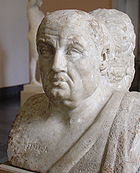
Senecan tragedy
Encyclopedia

Drama
Drama is the specific mode of fiction represented in performance. The term comes from a Greek word meaning "action" , which is derived from "to do","to act" . The enactment of drama in theatre, performed by actors on a stage before an audience, presupposes collaborative modes of production and a...
s, of which eight were written by the Roman
Ancient Rome
Ancient Rome was a thriving civilization that grew on the Italian Peninsula as early as the 8th century BC. Located along the Mediterranean Sea and centered on the city of Rome, it expanded to one of the largest empires in the ancient world....
Stoic
STOIC
STOIC was a variant of Forth.It started out at the MIT and Harvard Biomedical Engineering Centre in Boston, and was written in the mid 1970s by Jonathan Sachs...
philosopher and politician L. Annaeus Seneca (Seneca the Younger
Seneca the Younger
Lucius Annaeus Seneca was a Roman Stoic philosopher, statesman, dramatist, and in one work humorist, of the Silver Age of Latin literature. He was tutor and later advisor to emperor Nero...
). Rediscovered by Italian humanists in the mid-16th century, they became the models for the revival of tragedy on the Renaissance
Renaissance
The Renaissance was a cultural movement that spanned roughly the 14th to the 17th century, beginning in Italy in the Late Middle Ages and later spreading to the rest of Europe. The term is also used more loosely to refer to the historical era, but since the changes of the Renaissance were not...
stage. The two great, but very different, dramatic traditions of the age - French Neoclassical
Neoclassicism
Neoclassicism is the name given to Western movements in the decorative and visual arts, literature, theatre, music, and architecture that draw inspiration from the "classical" art and culture of Ancient Greece or Ancient Rome...
tragedy and Elizabethan tragedy - both drew inspiration from Seneca. The Senecan tragedy also focuses heavily on the supernatural elements.
French Neoclassical dramatic tradition, which reached its highest expression in the 17th-century tragedies of Pierre Corneille
Pierre Corneille
Pierre Corneille was a French tragedian who was one of the three great seventeenth-century French dramatists, along with Molière and Racine...
and Jean Racine
Jean Racine
Jean Racine , baptismal name Jean-Baptiste Racine , was a French dramatist, one of the "Big Three" of 17th-century France , and one of the most important literary figures in the Western tradition...
, drew on Seneca for form and grandeur of style. These Neoclassicists adopted Seneca's innovation of the confidant (usually a servant), his substitution of speech for action, and his moral hairsplitting.
The Elizabethan dramatists found Seneca's themes of bloodthirsty revenge more congenial to English taste than they did his form. The first English tragedy, Gorboduc
Gorboduc (play)
Gorboduc, also titled Ferrex and Porrex, is an English play from 1561. It was performed before Queen Elizabeth I on 18 January 1562, by the Gentlemen of the Inner Temple...
(1561), by Thomas Sackville
Thomas Sackville, 1st Earl of Dorset
Thomas Sackville, 1st Earl of Dorset was an English statesman, poet, dramatist and Freemason. He was the son of Richard Sackville, a cousin to Anne Boleyn. He was a Member of Parliament and Lord High Treasurer.-Biography:...
and Thomas Norton
Thomas Norton
Thomas Norton was an English lawyer, politician, writer of verse — but not, as has been claimed, the chief interrogator of Queen Elizabeth I.-Official career:...
, is a chain of slaughter and revenge written in direct imitation of Seneca. (As it happens, Gorboduc does follow the form as well as the subject matter of Senecan tragedy: but only a very few other English plays - e.g. The Misfortunes of Arthur
The Misfortunes of Arthur
The Misfortunes of Arthur, Uther Pendragon's son reduced into tragical notes is a play by the 16th-century English dramatist Thomas Hughes. Written in 1587, it was performed at Greenwich before Queen Elizabeth I on February 28, 1588...
- followed its lead in this.) Senecan influence is also evident in Thomas Kyd
Thomas Kyd
Thomas Kyd was an English dramatist, the author of The Spanish Tragedy, and one of the most important figures in the development of Elizabethan drama....
's The Spanish Tragedy
The Spanish Tragedy
The Spanish Tragedy, or Hieronimo is Mad Again is an Elizabethan tragedy written by Thomas Kyd between 1582 and 1592. Highly popular and influential in its time, The Spanish Tragedy established a new genre in English theatre, the revenge play or revenge tragedy. Its plot contains several violent...
and Shakespeare's Hamlet
Hamlet
The Tragical History of Hamlet, Prince of Denmark, or more simply Hamlet, is a tragedy by William Shakespeare, believed to have been written between 1599 and 1601...
: both share a revenge theme, a corpse-strewn climax, and ghosts among the cast, which can all be traced back to the Senecan model.

